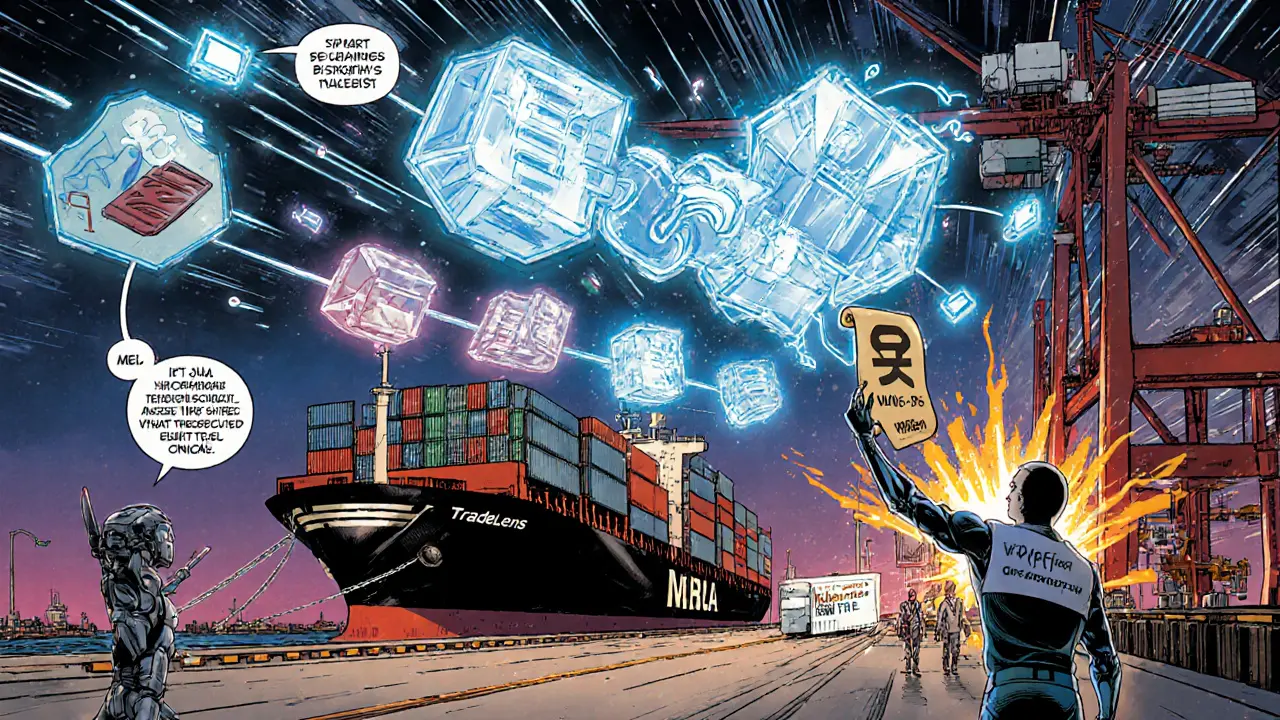- Home
- Blockchain
- Key Benefits of Blockchain for Modern Logistics

Key Benefits of Blockchain for Modern Logistics
Blockchain ROI Calculator for Logistics
Calculate Your Potential Blockchain ROI
Estimate the financial benefits of implementing blockchain in your logistics operations based on real-world data from the article.
Why logistics needs a tech shake‑up
Every freight forwarder, warehouse manager, and customs broker knows the pain: paperwork piles up, data gets lost, and counterfeit goods slip through. When a shipment takes days to clear because a bill of lading is stuck in a fax machine, the whole network feels the delay. blockchain logistics promises to cut the noise and let every player see the same, tamper‑proof record in real time.
What blockchain actually is - and how it fits into logistics
When we talk about Blockchain is a decentralized digital ledger that records transactions across multiple computers, we’re describing a system that does three things well: immutable record‑keeping, consensus‑driven validation, and programmable logic via Smart contract self‑executing code that runs when predefined conditions are met. In a logistics context, each event-pickup, customs clearance, temperature reading-gets a cryptographic hash (usually SHA‑256) and is added to a chain that no single party can rewrite.
To make those events actionable, most solutions hook IoT network of sensors that transmit data like GPS location or temperature devices directly to the ledger. The result is a single source of truth that bridges carriers, shippers, regulators, and insurers.
Core benefits that logistics firms see
- Transparency & traceability: 68 % of supply‑chain leaders cite lack of visibility as their top pain point (Deloitte, 2023). A blockchain record lets any authorized user view the exact status of a container without calling the carrier.
- Reduced paperwork: Traditional bills of lading can take 5‑10 days and involve 14+ copies. Platforms like TradeLens a blockchain‑based shipping platform developed by Maersk and IBM cut processing to a few hours and a single electronic document.
- Fraud prevention: Counterfeit goods cost the global economy $509 bn (OECD, 2022). Immutable tracking makes it nearly impossible to insert a fake product without alerting the network.
- Automated payments: Smart contracts trigger instant settlement once delivery verification hits predefined thresholds, trimming reconciliation time by up to 37 % (MIT, 2023).
- Regulatory compliance: FDA’s DSCSA and the EU’s sustainability reporting directives require electronic traceability-blockchain delivers the audit trail with a cryptographic seal.
Real‑world case studies
The hype is backed by numbers. Maersk global container shipping giant and IBM technology services leader processed over 30 million events on TradeLens before its 2023 wind‑down. Participating freight forwarders reported a 40 % reduction in documentation time, yet only 30 % of Maersk’s top 100 customers joined-highlighting the need for industry‑wide alignment.
In the pharma sector, DHL logistics provider piloted a blockchain‑AI hybrid that cut inventory errors by 33 % because the ledger fed clean, verified data into machine‑learning models.
Walmart’s food‑traceability initiative used OriginTrail decentralized knowledge graph for supply‑chain data to achieve 2.2‑second product tracing, a dramatic leap from the 7‑day norm.

Implementation roadmap - what you really need to do
- Pain‑point identification (2‑4 weeks): Pinpoint the exact process that loses money-often reconciliation or customs paperwork.
- Consortium formation (3‑9 months): Bring carriers, shippers, and regulators onto a shared governance model. Deloitte notes this stage consumes 42 % of total project time.
- Minimum viable product (4‑6 months): Deploy a pilot on a permissioned network like Hyperledger Fabric enterprise‑grade blockchain framework or a private Ethereum public blockchain that supports Solidity smart contracts instance.
- Incremental scaling (6‑12 months): Add more partners, integrate IoT feeds, and expand smart‑contract logic.
- Continuous optimization: Monitor TPS, latency, and data‑quality metrics; update consensus protocols as needed.
Typical costs range from $50 k for a basic consortium to $500 k+ for full‑scale, custom deployments (Acropolium, 2024). Consultant rates hover around $185 / hour for certified Hyperledger developers.
Challenges you’ll hit along the way
- Scalability: Most permissioned chains handle 10‑1 500 TPS; Visa processes 65 000 TPS. High‑volume, low‑value shipments may not see ROI.
- Data quality: Garbage in, garbage out. Without reliable IoT inputs at the point of origin, the ledger only records bad data (Harvard Business Review, 2023).
- Stakeholder alignment: Only 22 % of blockchain logistics projects succeed without industry‑wide standards (Deloitte, 2023). Negotiating data‑sharing agreements can take months.
- Regulatory uncertainty: Different jurisdictions impose varying encryption and audit‑trail requirements; ISO/IEC 27001:2022 compliance is a must.
Future outlook - where the tech is heading
Three trends will shape the next wave:
- AI integration: DHL’s pilot shows that blockchain‑verified data improves predictive inventory models by 33 %.
- Quantum‑resistant cryptography: NIST‑approved algorithms are slated for rollout by Q4 2025, protecting the ledger against future decryption threats.
- Cross‑chain interoperability: Emerging protocols aim to cut multi‑platform integration costs by 60 % by 2026, letting a shipment hop from Hyperledger to Ethereum without manual re‑entry.
Analysts agree that by 2030, roughly 65 % of global trade documentation will carry blockchain elements (Deloitte). Yet Gartner warns the buzz may fade by 2027, leaving only the core use cases-provenance, payments, compliance-alive.

Quick checklist for a successful rollout
- Define a narrow, high‑value use case before scaling.
- Secure at least three anchor partners for the consortium.
- Standardize data formats (GS1, EPCIS) early.
- Choose a permissioned platform that matches transaction volume.
- Invest in IoT sensor calibration and data‑governance processes.
- Plan for change management-train warehouse staff for 3+ weeks.
Frequently Asked Questions
Can blockchain replace existing ERP systems?
No. Blockchain acts as an add‑on layer that records immutable events. It integrates with ERP, WMS, or TMS via APIs, but it doesn’t handle core accounting or inventory logic.
What consensus mechanism works best for logistics?
Most consortia choose Proof of Authority or Practical Byzantine Fault Tolerance because they offer fast finality and controlled participation, unlike energy‑hungry Proof of Work.
How long does a typical deployment take?
Average end‑to‑end time is about 14‑15 months, with consortium negotiation taking the longest stretch.
Is blockchain secure enough for regulated industries?
When combined with TLS 1.2+ encryption and ISO/IEC 27001‑compliant governance, blockchain meets FDA, EU, and other regulator standards for data integrity.
What’s the ROI timeline?
Gartner reports that only 17 % of projects see full ROI within 24 months; however, firms focusing on documentation reduction and fraud prevention often break even in 12‑18 months.
Comparison: Traditional EDI vs Blockchain for Logistics
| Metric | EDI | Blockchain |
|---|---|---|
| Annual document volume | 24 billion | ~5 billion (growing) |
| Error rate | 15‑20 % | ~2 % (post‑validation) |
| Processing time (bill of lading) | 5‑10 days | 4‑6 hours |
| Transaction throughput | 65 000 TPS (centralized DB) | 10‑1 500 TPS (typical) |
| Implementation cost | $30 k‑$100 k (software licensing) | $50 k‑$500 k+ (consortium & smart contracts) |
While EDI still dominates sheer volume, blockchain’s error reduction and speed gains make it a compelling upgrade for high‑value, regulated shipments.
Cormac Riverton
I'm a blockchain analyst and private investor specializing in cryptocurrencies and equity markets. I research tokenomics, on-chain data, and market microstructure, and advise startups on exchange listings. I also write practical explainers and strategy notes for retail traders and fund teams. My work blends quantitative analysis with clear storytelling to make complex systems understandable.
Popular Articles
9 Comments
Write a comment Cancel reply
About
DEX Maniac is your hub for blockchain knowledge, cryptocurrencies, and global markets. Explore guides on crypto coins, DeFi, and decentralized exchanges with clear, actionable insights. Compare crypto exchanges, track airdrop opportunities, and follow timely market analysis across crypto and stocks. Stay informed with curated news, tools, and insights for smarter decisions.




Transparency across the supply chain is the single most powerful lever you can pull.
First, the transparency advantage you described is exactly the lever that can turn a chaotic supply chain into a predictable engine.
When every stakeholder can see the same immutable record, you eliminate the endless back‑and‑forth emails that waste hours.
In my experience coaching freight firms, the biggest ROI comes from slashing paperwork, because that frees up staff to focus on value‑added tasks.
A pilot that starts with a single high‑value customs clearance event is a smart way to prove the concept without overwhelming the team.
Make sure you engage the IT and operations groups early; the cultural shift is often the hidden cost.
Training should be hands‑on-run a few mock shipments where the smart contract triggers a payment automatically.
You’ll see the settlement time drop from days to minutes, which also improves cash flow for small carriers.
Don’t forget to standardize the data formats like GS1 or EPCIS before you write anything to the ledger.
Bad data in, bad data out-this is the single most common trap that trips up new implementations.
A permissioned Hyperledger Fabric network gives you the control you need while still providing the fast finality you want.
If you anticipate high volume, consider a hybrid approach where only the critical events are recorded on‑chain.
Keep an eye on the TPS numbers; if you routinely exceed a few thousand, you’ll need to plan for scaling early.
Regulatory compliance is easier when the audit trail is cryptographically sealed, but you still have to map local laws to the blockchain metadata.
Finally, measure success with clear KPIs-document processing time, error rate, and payment cycle reduction-and revisit them quarterly.
Stick to this roadmap and you’ll turn the technology hype into a real competitive edge.
There’s a hidden agenda behind every tech buzzword that promises to revolutionize logistics.
Large consortiums often use blockchain as a veneer to lock smaller players into opaque data‑sharing agreements.
The real profit motive is to monopolise the data streams and charge premium fees for access.
Watch out for clauses that force you to adopt proprietary IoT hardware whose firmware can be updated unilaterally.
Only a truly open and community‑governed network can safeguard against this centralisation of power.
If you want a realistic path forward, focus on the low‑hanging fruit first.
Start with a single transaction type-like customs clearance-where the benefit of an immutable record is crystal clear.
Involve the IT team early so they can set up the permissioned network without bottlenecking later phases.
Run a two‑week sprint to hash and store events, then measure the time saved versus the legacy process.
Once you have concrete numbers, bring the results to the board to secure buy‑in for scaling.
Remember, a step‑by‑step approach keeps the project manageable and the stakeholders happy.
The optimism in your roadmap is contagious! 😊
Seeing the potential for near‑real‑time traceability makes me think of all the missed‑delivery nightmares we could avoid.
Those smart‑contract‑driven payments could free up cash flow for small shippers, which is a game‑changer.
I especially love the idea of a unified audit trail-regulators will thank us for that.
Keep the momentum, and let’s watch the industry transform together. 🚀
Simple data standards are the foundation of any successful blockchain rollout.
Without GS1 or EPCIS tags, the ledger just becomes a glorified spreadsheet.
Make the effort to clean up your data at the source; it pays off in trust and speed.
A tidy dataset also reduces the risk of smart‑contract failures.
The current discourse flirts with buzzword overload rather than substance.
When every whitepaper touts ‘interoperability’ without a concrete protocol, it dilutes the value proposition.
Permissioned Hyperledger Fabric offers controlled access, but many vendors still push private Ethereum chains that lack enterprise‑grade governance.
Don’t be fooled by lofty promises; ask for concrete metrics on TPS, latency, and fault tolerance.
Only then can you assess whether the solution truly scales to global freight volumes.
Many of the promised gains evaporate when you look at real‑world pilots.
Love the collaborative spirit here! 🌈
Bringing together carriers, shippers, and regulators on a single ledger feels like a symphony where every instrument finally plays in tune.
When the smart contracts kick in, it’s like watching a well‑choreographed dance of data.
Let’s keep the conversation buzzing and share more success stories as they happen.
Definately agree that data quality is the biggest hurdle.
Even a tiny typo in a sensor reading can cascade into huge audit headaches.
Make sure the calibration process is solid before you trust the blockchain with it.
Simple checks early on save massive headaches later.